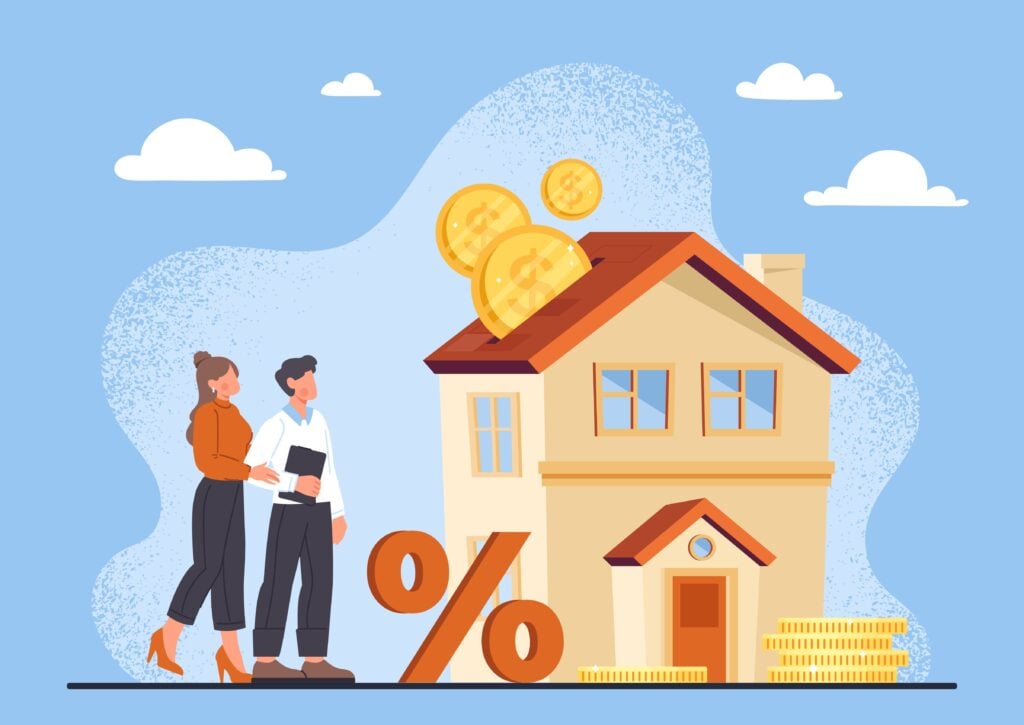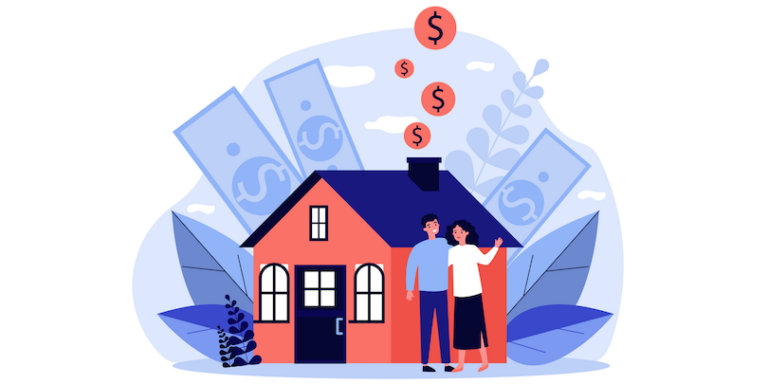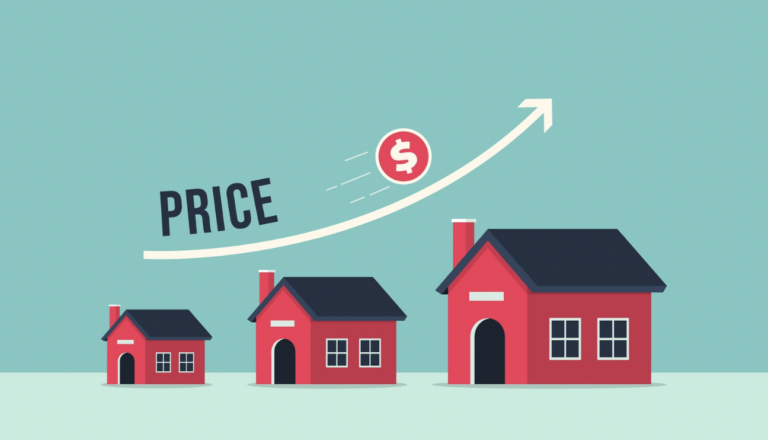
🏡 How much income do you need to afford the typical home? 🏡
To comfortably afford the median-priced home ($332,494), first-time buyers need a household income of $119,769. The median home is affordable for median earners in just four states and six of the 50 largest metro areas.
Affordability by City | Affordability by State | Salary Required for First-Time Buyers | Salary Required With 20% Down | Time to Save for a 20% Down Payment | Calculator: Salary to Afford a Home
Owning a home is one of the most effective ways for Americans to build wealth over time. But as home prices have soared, homeownership has increasingly become a privilege attainable only for the country's highest earners.
Across the U.S., most first-time buyers put down less than 10% on their home purchase, according to data from the National Association of Realtors. With 10% down, Clever's analysis shows first-time buyers must earn $119,769 to comfortably afford the median-priced home ($332,494). That's about $45,000 more than the typical household earns each year ($74,755).
With a 20% down payment, the median-priced home is affordable for the median earner in just four states and six of the country's 50 largest metros.
For one's home to be considered affordable, a household should spend no more than 28% of its gross monthly income on housing, while using an additional 8% to pay off debts, according to the popular 28/36 rule of housing affordability.
Many Americans have incomes far lower than what they need to become a homeowner. The typical household earns $74,755 annually, but the median income for home buyers in 2022 was $107,000, according to NAR data.
To learn more about how much income it takes to afford the typical home, Clever analyzed median home prices and median incomes for 50 metro areas and 48 states with available data. Read on to find out how much income a person needs to earn to afford a house in 2024.
Salary to Afford a Home: Key Statistics 💰
- Of the 50 largest U.S. metro areas, only six have median-priced homes considered affordable for median-income households. Jump to section 👇
- Pittsburgh is the most affordable metro for home buyers. Comfortably affording the city's median-priced home takes a household income of $59,919.
- Los Angeles is the least affordable city for home buyers. It takes an income of $249,471 to comfortably afford a median-priced home.
- The median-priced home is affordable for the median earner in just four states: West Virginia, Ohio, Iowa, and Indiana. 👇
- West Virginia is the most affordable state. Affording the median-priced home requires an income of about $47,405.
- California is the least affordable state. Affording the median home requires a household income of $222,132.
- The median home in the U.S. sells for $332,494, while the typical household earns $74,755.
- The typical first-time home buyer needs to earn $119,769 to comfortably afford the median-priced home with a 10% down payment. That's $45,000 more than the median household earns per year ($74,755). 👇
- The most expensive home most first-time buyers can afford today costs about $207,529 — 38% less than the current median-priced home.
- With a 20% down payment, a household must earn $98,202 annually to afford the median-priced home ($332,494). 👇
- 61% of Americans cannot afford the median-priced home, even after a 20% down payment.
- If a household saves $500 each month toward a down payment, it will take 11 years to afford a 20% down payment of $66,500 on the typical home. 👇
- For a median-income earner to comfortably afford the median-priced home, they would need a down payment of 45%. 👇
The Median Home Is Unaffordable in 44 of the 50 Largest U.S. Metros
Of the 50 largest U.S. metro areas, only six have home prices low enough to be considered affordable for the median-earning household.
To be considered affordable, housing payments should comprise no more than 28% of a household's annual income. But for the vast majority of cities, that's not enough to afford the median home at the median local income, even when posting a down payment of 20%.
Take Tampa, Florida, for example. The median home in this metro sells for $361,177. After a 20% down payment, the monthly mortgage payment including taxes and insurance costs $2,476 per month, or $29,712 annually, based on a 30-year mortgage.
To afford that cost without exceeding 28% of a household's income means a household must earn $106,116 each year. But the median household in Tampa earns just $69,290 per year — about $37,000 short of comfortably affording the median home.
The six cities where the median-priced home is affordable for median earners are:
- Pittsburgh, Pennsylvania
- Cleveland, Ohio
- St. Louis, Missouri
- Memphis, Tennessee
- Indianapolis, Indiana
- Birmingham, Alabama
In Pittsburgh, the median home sells for $199,573. After a 20% down payment, the mortgage payment, including taxes and insurance, costs $1,398 per month, or $16,777 per year, based on a 30-year mortgage.
To afford that mortgage without exceeding 28% of one's income, a household would need to earn about $59,919 per year. The median household income in Pittsburgh is $70,607, meaning it's possible to comfortably afford a median-priced home.
The table below compares incomes and home prices for the 50 most populous metros in the U.S. based on an interest rate of 7.22% and a 20% down payment.
| Rank | City | Local Median Home Sale Price | Annual Mortgage Payment on Median Home | Local Median Household Income | Income Needed to Afford the Median Home | Gap Between Suggested Income and Actual Income | House Affordability Ratio |
| 1 | Pittsburgh, PA | $199,573 | $16,777 | $70,607 | $59,919 | -$10,688 | 85% |
| 2 | Cleveland, OH | $182,652 | $15,786 | $65,198 | $56,378 | -$8,820 | 86% |
| 3 | St. Louis, MO | $225,674 | $18,688 | $74,531 | $66,743 | -$7,788 | 90% |
| 4 | Memphis, TN | $213,929 | $17,264 | $64,008 | $61,659 | -$2,349 | 96% |
| 5 | Indianapolis, IN | $257,584 | $20,552 | $75,824 | $73,398 | -$2,426 | 97% |
| 6 | Birmingham, AL | $235,212 | $18,260 | $67,242 | $65,216 | -$2,026 | 97% |
| 7 | Detroit, MI | $232,443 | $20,018 | $71,265 | $71,494 | $229 | 100% |
| 8 | Cincinnati, OH | $245,902 | $21,252 | $75,062 | $75,901 | $839 | 101% |
| 9 | Louisville, KY | $240,158 | $19,866 | $69,547 | $70,951 | $1,404 | 102% |
| 10 | Buffalo, NY | $237,672 | $20,489 | $68,698 | $73,174 | $4,476 | 107% |
| 11 | Baltimore, MD | $338,748 | $27,538 | $90,505 | $98,350 | $7,845 | 109% |
| 12 | Oklahoma City, OK | $219,463 | $20,290 | $66,301 | $72,465 | $6,164 | 109% |
| 13 | Columbus, OH | $268,548 | $23,209 | $75,777 | $82,891 | $7,114 | 109% |
| 14 | Kansas City, MO | $290,619 | $24,066 | $75,280 | $85,950 | $10,670 | 114% |
| 15 | Minneapolis, MN | $344,993 | $29,355 | $91,341 | $104,841 | $13,500 | 115% |
| 16 | Philadelphia, PA | $322,701 | $27,128 | $84,123 | $96,886 | $12,763 | 115% |
| 17 | Richmond, VA | $340,737 | $26,785 | $81,388 | $95,662 | $14,274 | 118% |
| 18 | Virginia Beach, VA | $312,396 | $24,557 | $74,556 | $87,705 | $13,149 | 118% |
| 19 | Washington DC | $509,273 | $38,834 | $117,432 | $138,693 | $21,261 | 118% |
| 20 | Hartford, CT | $319,302 | $28,637 | $85,723 | $102,274 | $16,551 | 119% |
| 21 | New Orleans, LA | $246,271 | $20,658 | $61,602 | $73,777 | $12,175 | 120% |
| 22 | Chicago, IL | $298,181 | $27,933 | $82,914 | $99,760 | $16,846 | 120% |
| 23 | Milwaukee, WI | $282,428 | $24,147 | $70,898 | $86,239 | $15,341 | 122% |
| 24 | Atlanta, GA | $354,695 | $28,921 | $84,876 | $103,289 | $18,413 | 122% |
| 25 | Raleigh, NC | $411,465 | $32,592 | $92,739 | $116,400 | $23,661 | 126% |
| 26 | Jacksonville, FL | $332,051 | $27,316 | $77,583 | $97,559 | $19,976 | 126% |
| 27 | Charlotte, NC | $357,887 | $28,348 | $77,154 | $101,243 | $24,089 | 131% |
| 28 | Houston, TX | $318,857 | $28,893 | $74,863 | $103,189 | $28,326 | 138% |
| 29 | San Antonio, TX | $307,739 | $27,885 | $70,538 | $99,591 | $29,053 | 141% |
| 30 | Salt Lake City, UT | $504,709 | $37,759 | $91,891 | $134,854 | $42,963 | 147% |
| 31 | Dallas, TX | $379,552 | $34,393 | $82,823 | $122,831 | $40,008 | 148% |
| 32 | Phoenix, AZ | $438,704 | $34,529 | $82,884 | $123,316 | $40,432 | 149% |
| 33 | Nashville, TN | $416,133 | $33,583 | $80,034 | $119,938 | $39,904 | 150% |
| 34 | Tampa, FL | $361,177 | $29,712 | $69,290 | $106,116 | $36,826 | 153% |
| 35 | Providence, RI | $412,693 | $35,160 | $81,784 | $125,573 | $43,789 | 154% |
| 36 | Las Vegas, NV | $402,657 | $30,543 | $70,797 | $109,082 | $38,285 | 154% |
| 37 | Orlando, FL | $379,039 | $31,182 | $71,857 | $111,364 | $39,507 | 155% |
| 38 | Austin, TX | $457,553 | $41,461 | $94,604 | $148,073 | $53,469 | 157% |
| 39 | Portland, OR | $523,489 | $41,047 | $89,312 | $146,595 | $57,283 | 164% |
| 40 | Denver, CO | $560,934 | $46,917 | $98,975 | $167,562 | $68,587 | 169% |
| 41 | Sacramento, CA | $549,332 | $42,770 | $89,237 | $152,749 | $63,512 | 171% |
| 42 | Seattle, WA | $669,912 | $52,670 | $106,909 | $188,106 | $81,197 | 176% |
| 43 | Boston, MA | $630,152 | $51,510 | $104,299 | $183,963 | $79,664 | 176% |
| 44 | Riverside, CA | $534,480 | $41,613 | $82,803 | $148,619 | $65,816 | 179% |
| 45 | Miami, FL | $441,399 | $36,312 | $70,769 | $129,686 | $58,917 | 183% |
| 46 | New York, NY | $568,905 | $49,043 | $91,562 | $175,153 | $83,591 | 191% |
| 47 | San Francisco, CA | $1,088,519 | $84,750 | $128,151 | $302,677 | $174,526 | 236% |
| 48 | San Diego, CA | $849,359 | $66,129 | $98,928 | $236,175 | $137,247 | 239% |
| 49 | San Jose, CA | $1,455,442 | $113,317 | $148,900 | $404,705 | $255,805 | 272% |
| 50 | Los Angeles, CA | $897,173 | $69,852 | $87,743 | $249,471 | $161,728 | 284% |
| Median home sale prices come from Zillow as of December 2023. Annual mortgage payments assume a 20% down payment and include principal, interest, taxes, and insurance (PITI). Income needed to afford a home assumes homeowners allocate no more than 28% of their gross monthly income to their housing costs. | |||||||
What costs go into affording a home?
Mortgage payments are comprised of multiple elements, not just the money you borrowed to purchase your home. The four main costs are often abbreviated as PITI and include:
- Principal: The amount you borrowed from the bank to purchase your home.
- Interest: The premium you pay to the bank in exchange for its help financing your home purchase.
- Taxes: The taxes you must pay your local government to maintain ownership of your property.
- Insurance: The premium you pay to your homeowners insurance provider to cover the cost of qualified damages to your home.
Only Four States Have Median-Priced Homes Considered Affordable
Of 48 states with available data, a median-priced home is not affordable for the typical household in 44 of them.
The only four states where the typical home is financially attainable for the median household are:
- West Virginia
- Ohio
- Iowa
- Indiana
California is the least affordable state for the average home buyer. The median home sells for $798,854. After a 20% down payment, the monthly mortgage payment costs about $5,183, or $62,197 annually.
To comfortably afford that mortgage, a household needs to bring in about $222,132 annually. But the median household in the state earns $91,551. In other words, the median household in California only makes about 41% of the income required to afford the median-priced home.
The most affordable state for the typical household is West Virginia. The median home sells for $175,432. After a 20% down payment, the monthly mortgage payment on that home is $1,106, or $13,273 annually.
To comfortably afford that mortgage in West Virginia, a household should make about $47,405 annually. The median household in the state generates $54,329 per year, meaning such a household can generally afford a median-priced home.
While home buyers can take advantage of these relatively low prices, home sellers should keep in mind that West Virginia has the highest real estate commission rate in the country.
The table below compares home prices and incomes for 48 states, based on the latest interest rates (7.22%) and a 20% down payment. Data for Alaska and Vermont is not available.
| Rank | State | Local Median Home Sale Price | Annual Mortgage Payment on Median Home | Local Median Household Income | Income Needed to Afford the Median Home | Gap Between Suggested Income and Actual Income | House Affordability Ratio |
| 1 | West Virginia | $175,432 | $13,273 | $54,329 | $47,405 | -$6,924 | 87% |
| 2 | Ohio | $200,959 | $17,368 | $65,720 | $62,029 | -$3,691 | 94% |
| 3 | Iowa | $217,833 | $19,005 | $69,588 | $67,875 | -$1,713 | 98% |
| 4 | Indiana | $229,424 | $18,305 | $66,785 | $65,374 | -$1,411 | 98% |
| 5 | Maryland | $328,639 | $26,716 | $94,991 | $95,415 | $424 | 100% |
| 6 | Virginia | $312,535 | $24,568 | $85,873 | $87,744 | $1,871 | 102% |
| 7 | Alabama | $230,779 | $17,916 | $59,674 | $63,986 | $4,312 | 107% |
| 8 | Michigan | $237,764 | $20,477 | $66,986 | $73,131 | $6,145 | 109% |
| 9 | Pennsylvania | $266,008 | $22,362 | $71,798 | $79,865 | $8,067 | 111% |
| 10 | Delaware | $349,233 | $26,000 | $82,174 | $92,858 | $10,684 | 113% |
| 11 | Missouri | $247,855 | $20,525 | $64,811 | $73,303 | $8,492 | 113% |
| 12 | Mississippi | $208,649 | $16,714 | $52,719 | $59,693 | $6,974 | 113% |
| 13 | New Jersey | $341,549 | $31,169 | $96,346 | $111,318 | $14,972 | 116% |
| 14 | North Dakota | $276,996 | $23,592 | $71,970 | $84,256 | $12,286 | 117% |
| 15 | Kansas | $238,387 | $22,642 | $68,925 | $80,866 | $11,941 | 117% |
| 16 | Oklahoma | $212,603 | $19,656 | $59,673 | $70,200 | $10,527 | 118% |
| 17 | Illinois | $269,931 | $25,287 | $76,708 | $90,309 | $13,601 | 118% |
| 18 | Wisconsin | $274,542 | $23,473 | $70,996 | $83,831 | $12,835 | 118% |
| 19 | Louisiana | $219,404 | $18,404 | $55,416 | $65,729 | $10,313 | 119% |
| 20 | Wyoming | $313,235 | $23,514 | $70,042 | $83,980 | $13,938 | 120% |
| 21 | Minnesota | $325,863 | $27,728 | $82,338 | $99,027 | $16,689 | 120% |
| 22 | Kentucky | $243,632 | $20,154 | $59,341 | $71,977 | $12,636 | 121% |
| 23 | Arkansas | $234,793 | $19,471 | $55,432 | $69,541 | $14,109 | 125% |
| 24 | South Carolina | $297,841 | $22,585 | $64,115 | $80,661 | $16,546 | 126% |
| 25 | Georgia | $317,484 | $25,887 | $72,837 | $92,453 | $19,616 | 127% |
| 26 | North Carolina | $321,103 | $25,434 | $67,481 | $90,837 | $23,356 | 135% |
| 27 | Tennessee | $306,778 | $24,758 | $65,254 | $88,420 | $23,166 | 136% |
| 28 | South Dakota | $308,182 | $26,754 | $69,728 | $95,551 | $25,823 | 137% |
| 29 | Nebraska | $266,548 | $26,808 | $69,597 | $95,742 | $26,145 | 138% |
| 30 | Connecticut | $383,709 | $34,413 | $88,429 | $122,904 | $34,475 | 139% |
| 31 | New Hampshire | $418,608 | $36,823 | $89,992 | $131,511 | $41,519 | 146% |
| 32 | Texas | $328,242 | $29,743 | $72,284 | $106,226 | $33,942 | 147% |
| 33 | Utah | $497,384 | $37,211 | $89,168 | $132,897 | $43,729 | 149% |
| 34 | Rhode Island | $412,693 | $35,160 | $81,854 | $125,573 | $43,719 | 153% |
| 35 | Arizona | $415,003 | $32,663 | $74,568 | $116,654 | $42,086 | 156% |
| 36 | Nevada | $425,279 | $32,259 | $72,333 | $115,211 | $42,878 | 159% |
| 37 | Florida | $379,341 | $31,207 | $69,303 | $111,453 | $42,150 | 161% |
| 38 | Idaho | $434,942 | $33,077 | $72,785 | $118,133 | $45,348 | 162% |
| 39 | New Mexico | $340,651 | $27,479 | $59,726 | $98,139 | $38,413 | 164% |
| 40 | Maine | $391,378 | $32,203 | $69,543 | $115,012 | $45,469 | 165% |
| 41 | Massachusetts | $560,059 | $45,780 | $94,488 | $163,501 | $69,013 | 173% |
| 42 | Washington | $576,453 | $45,322 | $91,306 | $161,863 | $70,557 | 177% |
| 43 | Colorado | $531,900 | $44,489 | $89,302 | $158,889 | $69,587 | 178% |
| 44 | Oregon | $485,725 | $38,086 | $75,657 | $136,020 | $60,363 | 180% |
| 45 | Hawaii | $704,027 | $49,370 | $92,458 | $176,323 | $83,865 | 191% |
| 46 | New York | $497,985 | $42,929 | $79,557 | $153,318 | $73,761 | 193% |
| 47 | Montana | $513,507 | $41,790 | $67,631 | $149,250 | $81,619 | 221% |
| 48 | California | $798,854 | $62,197 | $91,551 | $222,132 | $130,581 | 243% |
| Alaska | Insufficient Data | ||||||
| Vermont | Insufficient Data | ||||||
| Median home sale prices come from Zillow as of December 2023. Annual mortgage payments assume a 20% down payment and include principal, interest, taxes, and insurance (PITI). Income needed to afford a home assumes homeowners allocate no more than 28% of their gross monthly income to their housing costs. | |||||||
First-Time Buyers Must Earn $120,000 to Afford the Median Home
First-time home buyers face an added disadvantage in the housing market — being less able to afford a down payment. The typical first-time buyer makes a down payment of 8% of the home's price, compared to 19% for repeat buyers, according to data from the NAR.
To comfortably afford the median-priced home in the U.S. ($332,494) with a 10% down payment, a household needs to earn $119,769 annually. That's based on the current interest rate of 7.22% over a 30-year mortgage.
If that income was lower, the monthly mortgage payment ($2,795) would exceed 28% of the household's income.
The median household in the U.S. makes about $74,755 — $45,000 less than they need to afford the median-priced home as a first-time buyer. The most expensive home the median household could comfortably afford after a 10% down payment is $207,529.
If mortgage rates dropped to 2.5% tomorrow, that same household would be able to afford a home that cost $300,000 — underscoring the impact of high mortgage rates on affordability. However, that figure is still below the national median home price of $332,494.
How Much Income Do You Need to Afford a Home With 10% Down?
The table below shows how much household income a first-time buyer would need to earn to comfortably afford a home at a certain price and interest rate, based on a 10% down payment.
| Income Required: Home Price vs. Interest Rate | $200,000 | $300,000 | $332,494 | $400,000 | $417,700 | $500,000 | $600,000 | $700,000 |
| 2.00% | $48,088 | $72,132 | $79,945 | $96,176 | $100,432 | $120,221 | $144,265 | $168,309 |
| 2.50% | $50,055 | $75,083 | $83,216 | $100,111 | $104,541 | $125,139 | $150,166 | $175,194 |
| 3.00% | $52,098 | $78,148 | $86,612 | $104,197 | $108,808 | $130,246 | $156,295 | $182,345 |
| 3.50% | $54,215 | $81,323 | $90,131 | $108,431 | $113,229 | $135,538 | $162,646 | $189,754 |
| 4.00% | $56,404 | $84,606 | $93,770 | $112,808 | $117,800 | $141,010 | $169,212 | $197,414 |
| 4.50% | $58,662 | $87,993 | $97,524 | $117,324 | $122,515 | $146,655 | $175,986 | $205,317 |
| 5.00% | $60,987 | $91,480 | $101,389 | $121,973 | $127,371 | $152,467 | $182,960 | $213,453 |
| 5.50% | $63,376 | $95,063 | $105,360 | $126,751 | $132,360 | $158,439 | $190,127 | $221,815 |
| 6.00% | $65,826 | $98,739 | $109,433 | $131,652 | $137,477 | $164,564 | $197,477 | $230,390 |
| 6.50% | $68,334 | $102,501 | $113,604 | $136,669 | $142,716 | $170,836 | $205,003 | $239,170 |
| 7.00% | $70,898 | $106,347 | $117,866 | $141,796 | $148,071 | $177,245 | $212,694 | $248,143 |
| 7.22% | $72,043 | $108,064 | $119,769 | $144,086 | $150,462 | $180,107 | $216,129 | $252,150 |
| 7.50% | $73,514 | $110,271 | $122,215 | $147,028 | $153,534 | $183,785 | $220,542 | $257,299 |
| 8.00% | $76,179 | $114,269 | $126,646 | $152,359 | $159,101 | $190,449 | $228,538 | $266,628 |
| 8.50% | $78,891 | $118,336 | $131,154 | $157,782 | $164,764 | $197,227 | $236,673 | $276,118 |
A new home (median price of $417,700) is even more out of reach. First-time home buyers need to make double the median household income to get close to the $150,462 needed to comfortably afford mortgage payments on a home of that price.
With 20% Down, Buyers Need $98,000 Annually for the Median-Priced Home
Households with enough saved to afford a 20% down payment have more wiggle room in terms of the annual income required to comfortably afford a median-priced home ($332,494).
After putting $66,500 down, which is 20% of the median-priced home, the monthly mortgage payment costs $2,291, or $27,497 annually. To afford that mortgage without it exceeding 28% of gross income, a household needs to earn $98,202 — about $23,000 more than the typical household income of $74,755.
With a 20% down payment, a household that earns the national median income of $74,755 can only afford a home that costs $253,105 — 24% less than the median-priced home. That drastically limits the pool of available homes. Only 11% of new homes sell for less than $300,000, according to a 2023 analysis by John Burns Research and Consulting.
For a household earning the median income to afford the median-priced home with a 20% down payment, mortgage rates would need to drop from 7.22% to 4%.
How Much Income Do You Need to Afford a Home With 20% Down?
The table below shows how much money a household needs to earn each year to comfortably afford a home after putting 20% down.
| Income Required: Home Price vs. Interest Rate | $200,000 | $300,000 | $332,494 | $400,000 | $417,700 | $500,000 | $600,000 | $700,000 |
| 2.00% | $37,777 | $56,666 | $62,803 | $75,554 | $78,898 | $94,443 | $113,332 | $132,220 |
| 2.50% | $39,526 | $59,289 | $65,711 | $79,052 | $82,550 | $98,815 | $118,578 | $138,341 |
| 3.00% | $41,342 | $62,013 | $68,730 | $82,684 | $86,342 | $103,355 | $124,026 | $144,697 |
| 3.50% | $43,224 | $64,835 | $71,858 | $86,447 | $90,272 | $108,059 | $129,671 | $151,282 |
| 4.00% | $45,169 | $67,753 | $75,092 | $90,338 | $94,335 | $112,922 | $135,507 | $158,091 |
| 4.50% | $47,176 | $70,764 | $78,429 | $94,352 | $98,527 | $117,940 | $141,528 | $165,116 |
| 5.00% | $49,243 | $73,864 | $81,864 | $98,485 | $102,843 | $123,106 | $147,728 | $172,349 |
| 5.50% | $51,366 | $77,049 | $85,394 | $102,732 | $107,278 | $128,415 | $154,098 | $179,781 |
| 6.00% | $53,544 | $80,316 | $89,015 | $107,088 | $111,826 | $133,860 | $160,632 | $187,404 |
| 6.50% | $55,774 | $83,661 | $92,722 | $111,547 | $116,483 | $139,434 | $167,321 | $195,208 |
| 7.00% | $58,053 | $87,079 | $96,511 | $116,105 | $121,243 | $145,132 | $174,158 | $203,184 |
| 7.22% | $59,070 | $88,605 | $98,202 | $118,140 | $123,368 | $147,676 | $177,211 | $206,746 |
| 7.50% | $60,378 | $90,567 | $100,377 | $120,756 | $126,099 | $150,945 | $181,134 | $211,323 |
| 8.00% | $62,747 | $94,121 | $104,315 | $125,494 | $131,047 | $156,868 | $188,241 | $219,615 |
| 8.50% | $65,157 | $97,736 | $108,322 | $130,315 | $136,081 | $162,893 | $195,472 | $228,051 |
Saving for a 20% Down Payment Takes Years
Coming up with a 20% down payment is no simple feat. If a household saves $1,000 each month — already a lofty goal — it will take five and a half years to save $66,500, which is a 20% down payment on the median-priced home ($332,494).
At a more manageable pace of $500 per month, saving for a down payment of that size would take a little over 11 years — assuming home prices don't rise higher in that time frame.
The table below shows how long it would take to save for a 20% down payment on the typical home ($332,494). To save up for that down payment in one year, a household must save $5,542 each month.
| Time to Save | Monthly Amount to Save |
| 1 year | $5,542 |
| 2 years | $2,771 |
| 3 years | $1,847 |
| 4 years | $1,385 |
| 5 years | $1,108 |
| 6 years | $924 |
| 7 years | $792 |
| 8 years | $693 |
| 9 years | $616 |
| 10 years | $554 |
Experts often recommend would-be buyers put down 20% when purchasing a home to lower monthly payments and avoid paying extra for private mortgage insurance. But that goal has become less attainable over time. The last year that the median buyer put down 20% was 1989, according to NAR data.
Today, the median buyer puts down 15% of a home's purchase price. The typical repeat buyer puts down 19%, while new buyers put down 8%.
Affording the Median Home on the Median Income Takes a 45% Down Payment
If a family earning the median household income ($74,755) was dead set on buying the median-priced home while spending a reasonable portion of their income, they'd need to seriously increase their down payment — all the way up to 45%, given current interest rates.
The table below shows how the annual income required to afford the median-priced home ($332,494) declines as one's down payment increases.
| Down Payment % | Total Annual Expense | Income Needed |
| 0% | $36,249 | $129,461 |
| 1% | $35,978 | $128,492 |
| 2% | $35,706 | $127,523 |
| 3% | $35,435 | $126,553 |
| 4% | $35,164 | $125,584 |
| 5% | $34,892 | $124,615 |
| 6% | $34,621 | $123,646 |
| 7% | $34,349 | $122,677 |
| 8% | $34,078 | $121,707 |
| 9% | $33,807 | $120,738 |
| 10% | $33,535 | $119,769 |
| 11% | $33,264 | $118,800 |
| 12% | $32,993 | $117,831 |
| 13% | $32,721 | $116,862 |
| 14% | $32,450 | $115,892 |
| 15% | $32,178 | $114,923 |
| 16% | $31,907 | $113,954 |
| 17% | $31,636 | $112,985 |
| 18% | $31,364 | $112,016 |
| 19% | $31,093 | $111,046 |
| 20% | $27,497 | $98,202 |
| 21% | $27,225 | $97,233 |
| 22% | $26,954 | $96,264 |
| 23% | $26,683 | $95,295 |
| 24% | $26,411 | $94,326 |
| 25% | $26,140 | $93,357 |
| 26% | $25,868 | $92,387 |
| 27% | $25,597 | $91,418 |
| 28% | $25,326 | $90,449 |
| 29% | $25,054 | $89,480 |
| 30% | $24,783 | $88,511 |
| 31% | $24,512 | $87,541 |
| 32% | $24,240 | $86,572 |
| 33% | $23,969 | $85,603 |
| 34% | $23,697 | $84,634 |
| 35% | $23,426 | $83,665 |
| 36% | $23,155 | $82,696 |
| 37% | $22,883 | $81,726 |
| 38% | $22,612 | $80,757 |
| 39% | $22,341 | $79,788 |
| 40% | $22,069 | $78,819 |
| 41% | $21,798 | $77,850 |
| 42% | $21,527 | $76,880 |
| 43% | $21,255 | $75,911 |
| 44% | $20,984 | $74,942 |
| 45% | $20,712 | $73,973 |
| 46% | $20,441 | $73,004 |
| 47% | $20,170 | $72,034 |
| 48% | $19,898 | $71,065 |
| 49% | $19,627 | $70,096 |
| 50% | $19,356 | $69,127 |
Calculator: How Much House Can You Afford?
The calculator below provides a rough estimate of how expensive a home a household can afford based on its income, amount saved for a down payment, expected mortgage rate, and other factors.
Methodology
Data sources for this study include the U.S. Census Bureau, the American Community Survey, the Federal Reserve, the U.S. Department of Housing and Urban Development, Zillow, Bankrate, Rocket Mortgage, Integrated Public Use Microdata Series (IPUMS), and Don't Quit Your Day Job (DQYDJ). Data analysis took place in March 2024.
About Clever
Since 2017, Clever Real Estate has been on a mission to make selling or buying a home easier and more affordable for everyone. 12 million annual readers rely on Clever's library of educational content and data-driven research to make smarter real estate decisions—and to date, Clever has helped consumers save more than $160 million on realtor fees. Clever's research has been featured in The New York Times, Business Insider, Inman, Housing Wire, and many more.
More Research From Clever
Articles You May Like
Frequently Asked Questions About the Salary to Afford a Home
How much house can I afford if I make $70,000 a year?
With interest rates at about 7%, a household making $70,000 can comfortably afford a home in the price range of $200,000 to $240,000 — depending on the amount of their down payment and other factors. Learn more about the income needed to afford a home.
How much house can I afford if I make $36,000 a year?
With interest rates around 7%, a household making $36,000 annually can only afford a home that costs about $100,000 to $140,000 — depending on the size of their down payment and other factors. Learn more about the salary required to afford a home.
How long does it take to save for a down payment?
If a household saves $1,000 per month, it will take five and a half years to afford a 20% down payment on the median-priced home. At $500 per month, it will take a little over 11 years. Learn more about the time it takes to save for a down payment.





